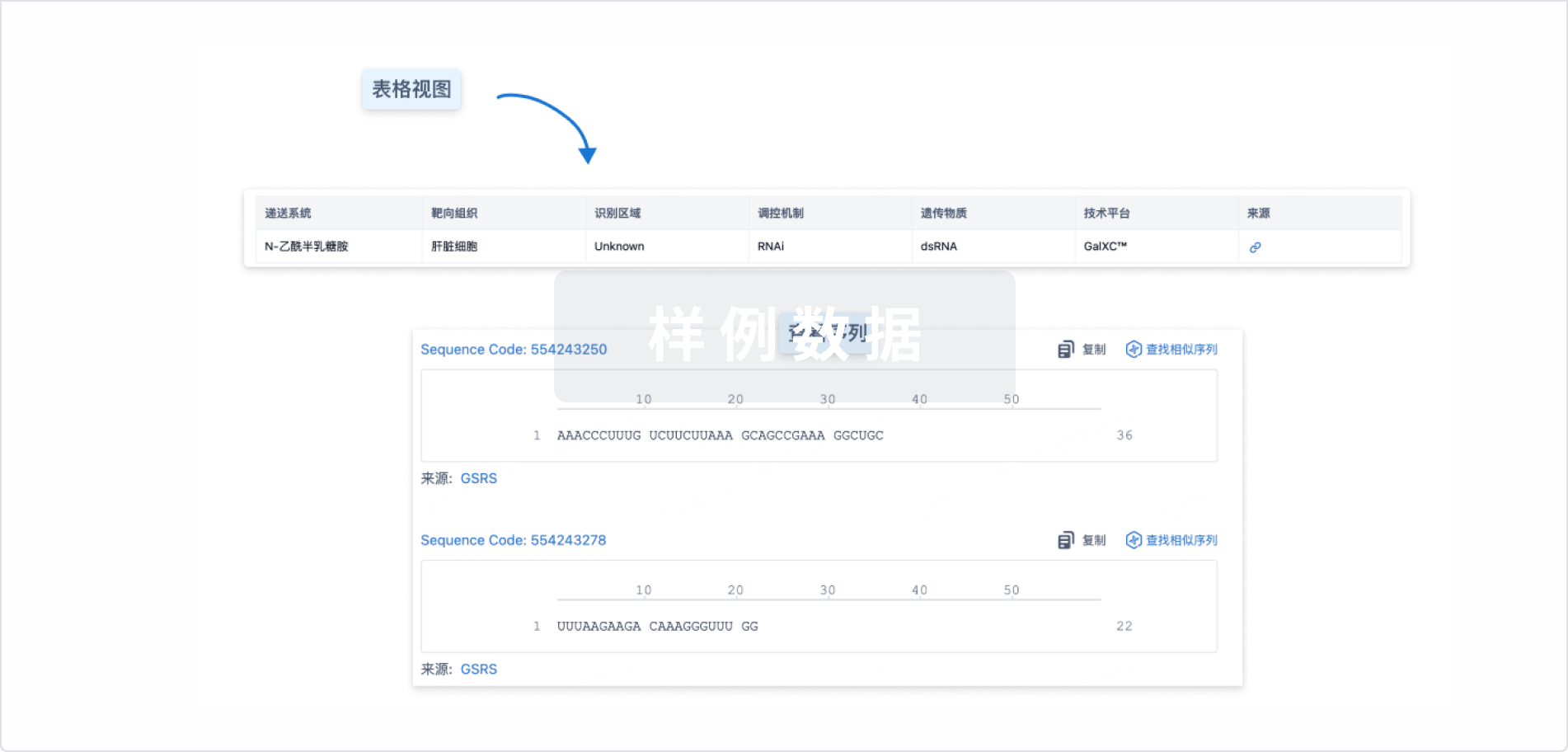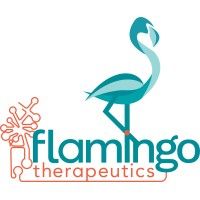预约演示
更新于:2025-08-09
Danvatirsen
更新于:2025-08-09
概要
基本信息
药物类型 ASO |
别名 Danvatirsen-sodium、IONIS-STAT3RX、ISIS-STAT3RX + [9] |
靶点 |
作用方式 抑制剂 |
作用机制 STAT3抑制剂(信号转导和转录激活因子-3抑制剂) |
在研适应症 |
非在研适应症 |
最高研发阶段临床2期 |
首次获批日期- |
最高研发阶段(中国)- |
特殊审评- |
登录后查看时间轴
结构/序列
使用我们的RNA技术数据为新药研发加速。
登录
或

Sequence Code 526076414

来源: *****
关联
16
项与 Danvatirsen 相关的临床试验NCT05986240
A Phase I Study Investigating the Safety & Efficacy of Danvatirsen as Monotherapy Followed by Combination With Venetoclax in Patients With Relapsed/Refractory MDS & AML
This is a Phase 1 study investigating the safety and efficacy of Danvatirsen as a monotherapy followed by combination with Venetoclax in patients with relapsed/refractory myelodysplastic syndromes (MDS) or acute myeloid leukemia (AML).
Funding Source: FDA OOPD
Funding Source: FDA OOPD
开始日期2024-05-08 |
申办/合作机构 |
NCT05814666
An Open-Label, Phase II, Randomized, Controlled Study of Danvatirsen Plus Pembrolizumab Compared to Pembrolizumab Alone in Recurrent or Metastatic Head and Neck Squamous Cell Carcinoma (HNSCC)
Open-label, Phase II, randomized, controlled study evaluating the efficacy and safety of danvatirsen in combination with pembrolizumab compared with pembrolizumab alone as first-line treatment of patients with recurrent/metastatic (R/M) HNSCC. Two-thirds of patients will be randomized to receive danvatirsen and pembrolizumab and one-third will be randomized to receive pembrolizumab alone.
开始日期2023-05-30 |
申办/合作机构 |
NCT03794544
A Phase 2 Open-label, Multicenter, Randomized, Multidrug Platform Study of Neoadjuvant Durvalumab Alone or in Combination With Novel Agents in Subjects With Resectable, Early-stage (I [> 2 cm] to IIIA) Non-small Cell Lung Cancer (NeoCOAST)
Study D9108C00002 (NeoCOAST) is a platform study assessing the effectiveness and safety of neoadjuvant durvalumab alone or in combination with novel agents in participants with resectable, early-stage (Stage I [>2cm] to IIIA) non-small cell lung cancer (NSCLC).
开始日期2019-03-08 |
申办/合作机构 |
100 项与 Danvatirsen 相关的临床结果
登录后查看更多信息
100 项与 Danvatirsen 相关的转化医学
登录后查看更多信息
100 项与 Danvatirsen 相关的专利(医药)
登录后查看更多信息
21
项与 Danvatirsen 相关的文献(医药)2025-05-01·Immunity Inflammation and Disease
Oligonucleotide‐Based Modulation of Macrophage Polarization: Emerging Strategies in Immunotherapy
Review
作者: Zhang, Hanfu ; Qian, Cheng ; Yu, Yizhi
ABSTRACT:
Background:
Recent advances in immunotherapy have spotlighted macrophages as central mediators of disease treatment. Their polarization into pro‑inflammatory (M1) or anti‑inflammatory (M2) states critically influences outcomes in cancer, autoimmunity, and chronic inflammation. Oligonucleotides have emerged as highly specific, scalable, and cost‑effective agents for reprogramming macrophage phenotypes.
Objective:
To review oligonucleotide strategies—including ASOs, siRNAs, miRNA mimics/inhibitors, and aptamers—for directing macrophage polarization and their therapeutic implications.
Review Scope:
We examine key signaling pathways governing M1/M2 phenotypes, describe four classes of oligonucleotides and their mechanisms, and highlight representative preclinical and clinical applications.
Key Insights:
Agents such as AZD9150, MRX34, and AS1411 demonstrate macrophage reprogramming in cancer, inflammation, and infection models. Advances in ligand‑conjugated nanoparticles and chemical modifications improve delivery and stability, yet immunogenicity, off‑target effects, and formulation challenges remain significant barriers.
Future Perspectives:
Optimizing delivery platforms, enhancing molecular stability, and rigorous safety profiling are critical. Integration with emerging modalities—such as engineered CAR‑macrophages—will enable precise, disease‑specific interventions, and advance oligonucleotide‑guided macrophage modulation toward clinical translation.
2025-04-01·MedComm
STAT3 Signaling Pathway in Health and Disease
Review
作者: Tabrez, Shams ; Alhashmi, Mohammad Hassan ; Samad, Md Abdus ; Ahmad, Iftikhar ; Hasan, Aakifah ; Al‐Abbasi, Fahad A. ; Ayub, Arusha ; Kumer, Ajoy
ABSTRACT:
Signal transducer and activator of transcription 3 (STAT3) is a critical transcription factor involved in multiple physiological and pathological processes. While STAT3 plays an essential role in homeostasis, its persistent activation has been implicated in the pathogenesis of various diseases, particularly cancer, bone‐related diseases, autoimmune disorders, inflammatory diseases, cardiovascular diseases, and neurodegenerative conditions. The interleukin‐6/Janus kinase (JAK)/STAT3 signaling axis is central to STAT3 activation, influencing tumor microenvironment remodeling, angiogenesis, immune evasion, and therapy resistance. Despite extensive research, the precise mechanisms underlying dysregulated STAT3 signaling in disease progression remain incompletely understood, and no United States Food and Drug Administration (USFDA)‐approved direct STAT3 inhibitors currently exist. This review provides a comprehensive evaluation of STAT3's role in health and disease, emphasizing its involvement in cancer stem cell maintenance, metastasis, inflammation, and drug resistance. We systematically discuss therapeutic strategies, including JAK inhibitors (tofacitinib, ruxolitinib), Src Homology 2 domain inhibitors (S3I‐201, STATTIC), antisense oligonucleotides (AZD9150), and nanomedicine‐based drug delivery systems, which enhance specificity and bioavailability while reducing toxicity. By integrating molecular mechanisms, disease pathology, and emerging therapeutic interventions, this review fills a critical knowledge gap in STAT3‐targeted therapy. Our insights into STAT3 signaling crosstalk, epigenetic regulation, and resistance mechanisms offer a foundation for developing next‐generation STAT3 inhibitors with greater clinical efficacy and translational potential.
2024-07-01·BMJ Oncology
Preclinical study and parallel phase II trial evaluating antisense STAT3 oligonucleotide and checkpoint blockade for advanced pancreatic, non-small cell lung cancer and mismatch repair-deficient colorectal cancer
Article
作者: Couillault, Coline ; Tang, Chad ; Piha-Paul, Sarina A ; Pant, Shubham ; Dai, James ; Karp, Daniel D ; Nicholas, Courtney ; Hartley, Genevieve P ; Proia, Theresa ; Yuan, Ying ; Fu, Siqing ; Lin, Heather ; Curran, Michael A ; Dhebat, Sarah ; Yap, Timonthy A ; Hong, David S ; Subbiah, Vivek ; Tsimberidou, Apostolia M ; Guerrero, Paola ; Srinivasamani, Anupallavi ; Dumbrava, Ecaterina E Ileana ; Naing, Aung ; Rodon Ahnert, Jordi
Objective:
To evaluate signal transducer and activator of transcription 3 (STAT3) inhibition we conducted a co-clinical trial testing danvatirsen, a STAT3 antisense oligonucleotide (ASO) and checkpoint inhibition in conjunction with preclinical experiments.
Methods and analysis:
Orthotopically implanted pancreatic cancer (pancreatic adenocarcinoma (PDAC)) was treated with STAT3 ASO with immune checkpoint inhibition. Tumour infiltrating immune cell populations were characterised via flow cytometry. In vitro experiments evaluated STAT3 inhibition in pancreatic stellate cells (PSCs) and myeloid-derived suppressor cells (MDSCs).A phase II trial employing a Simon II stage design tested the clinical efficacy of danvatirsen and durvalumab in non-small cell lung cancer (NSCLC), PDAC and mismatch repair-deficient colorectal cancer (MRD CRC). The primary objective was 4-month disease control rate (DCR).
Results:
In vivo studies identified improvement in survival of PDAC implanted mice treated with STAT3 ASO and checkpoint inhibition. Within tumour-infiltrating lymphocytes there was expansion of CD4 and PD-1+ CD8 populations with STAT3 ASO.Thirty-seven patients (29 PDAC, 7 NSCLC and 1 MRD CRC) from a single institution started treatment on trial between April 2017 and March 2020. No objective responses were observed. Four of six (66.7%, 95% CI 22.3% to 95.7%) NSCLC and 4 of 23 (17.4%, 95% CI 5% to 38.8%) PDAC patients exhibited 4-month DCR. Follow-up in vitro studies revealed an anti-inflammatory and pro-tumour effect of STAT3 ASO mediated by PSCs and MDSCs distinct from ablation of STAT3.
Conclusion:
Although durvalumab and danvatirsen met the primary endpoint, no objective responses were observed. A rationale for the lack of objective responses is danvatirsen-induced myeloid immune suppression.
Trial registration number:
NCT02983578
.
34
项与 Danvatirsen 相关的新闻(医药)2025-04-15
Flamingo Therapeutics Announces Poster Presentation on the Immune-Modulatory Effects of Danvatirsen at the American Association for Cancer Research (AACR) Annual Meeting
Leuven (Belgium), Strasbourg (France), Philadelphia (USA) – April 15, 2025 /PRNewswire/- Flamingo Therapeutics (“Flamingo”) today announced that an abstract has been accepted for presentation at the American Association for Cancer Research (AACR) annual meeting being held in Chicago, IL from April 25-30, 2025.
Poster presentation details are as follows:
Poster Title: “ASO-mediated STAT3 knockdown relieves immunosuppression sensitizing tumors to immunotherapies”
Session Category/Title: Immunology/Modulation of Tumor Microenvironment: Enhancing Immunogenicity and Counteracting Suppression
Session Time: 4/28/2025 9:00:00 AM - 12:00:00 PM
Location: Poster Section 38
Published Abstract Number: 2244
For more information, please visit the AACR Annual Meeting 2025 website.
About Flamingo Therapeutics
Flamingo is pioneering RNA-targeted therapies for oncology with a clinical-stage pipeline targeting undruggable transcription factors and long non-coding RNAs. Flamingo has an alliance with Ionis Pharmaceuticals and is supported by well-known biotechnology investors including Abrdn (formerly funds managed by Tekla Capital Management LLC), Andera Partners, Bpifrance Large Venture, Bpifrance through its FABS and Fonds Biothérapies Innovantes et Maladies Rares funds, Eurazeo - Kurma Partners, Perceptive Advisors, PMV, Pontifax, Sphera, and VIB.
Flamingo has initiated a Phase II trial ‘PEMDA-HN’ evaluating the STAT3 targeting agent danvatirsen, in combination with pembrolizumab, in patients with head and neck squamous cell carcinoma (HNSCC). A Phase I investigator initiated trial study has also been initiated evaluating danvatirsen as a monotherapy and in combination with venetoclax in AML/MDS patients.
For more information on Flamingo, please visit:
https://flamingotx.com
PEMDA-HN (head and neck cancer) on clinicaltrials.gov:
https://clinicaltrials.gov/study/NCT05814666
Danvatirsen monotherapy followed by combination with venetoclax in relapsed/ refractory AML and MDS on clincaltrials.gov:
https://classic.clinicaltrials.gov/ct2/show/NCT05986240
Please engage with us on LinkedIn:
https://www.linkedin.com/company/flamingo-therapeutics.
Flamingo Media and Investor Contact:
Amy Conrad Juniper Point (858) 366-3243
amy@juniper-point.com
免疫疗法AACR会议临床2期临床1期
2025-03-27
·小药说药
-01-
引言
趋化因子是负责免疫细胞运输和淋巴组织发育的细胞因子亚家族。目前,据报道有50种不同的趋化因子,根据其主要蛋白质结构的前两个半胱氨酸(C)残基的位置,可分为四大类,即C、CC、CXC和CX3C趋化因子。
每个免疫细胞亚群都有不同的趋化因子受体表达模式,这使得它们对趋化因子有不同的反应,并根据每个环境的特殊需要迁移。在癌症中,它们在免疫细胞迁移到肿瘤中的模式中起着关键作用,从而形成肿瘤微环境的免疫特征,通常朝向促肿瘤形成状态。
此外,趋化因子可以直接靶向肿瘤微环境中的非免疫细胞,包括肿瘤细胞、基质细胞和血管内皮细胞。因此,趋化因子参与多种癌症发展过程,如血管生成、转移、癌细胞增殖、干性和侵袭性,是疾病进展的关键决定因素,对患者预后和治疗反应有很大影响。由于它们在癌细胞和免疫浸润细胞中重要的调节功能,使得趋化因子配体及其受体成为非常强大的治疗靶点。
-02-
一、趋化因子在肿瘤免疫中的作用
免疫逃避和免疫抑制细胞的募集
趋化因子在引导免疫细胞迁移中起着至关重要的作用,而免疫细胞迁移是启动和传递有效的抗肿瘤免疫反应所必需的。TME中的趋化因子分泌通常会发生改变,异常的趋化因子分布可促进免疫抑制的促肿瘤细胞(即Treg细胞、MDSC和TAM)分化和浸润到肿瘤中。
Treg细胞的趋化因子受体CCR4的表达高于其他CD4+T细胞,其响应CCL22,一种由TAM和原发肿瘤细胞产生的趋化因子。除了CCR4外,Treg细胞还可以表达其他能够介导其浸润TME的趋化因子受体,如CCR5或CCR10,其配体CCL28存在于TME的缺氧区域。
巨噬细胞主要通过CCL2–CCR2信号通路招募到TME中。CCL2的肿瘤表达与许多肿瘤中TAM的数量相关,并且通常与患者预后不良相关。与Treg细胞一样,TAM也可以抑制肿瘤相关抗原(TAA)特异性CD8+T细胞活化。与TAM非常相似,髓源性抑制细胞(MDSC)也可以通过CCL2–CCR2信号被招募到TEM中。此外,诱导单核细胞向肿瘤募集的其他趋化因子还有CCL5、CCL7、CCL15、CXCL8和CXCL12。
浆细胞样树突状细胞(pDC)是一种罕见的免疫细胞,也能抑制抗肿瘤免疫反应。肿瘤和基质细胞产生CXCL12,它是趋化因子受体CXCR4的配体,由pDCs表达。因此,CXCL12是pDC进入TME的关键分子。此外,CXCL12还对pDC发挥保护作用,防止其发生凋亡,延长其免疫抑制作用。
肿瘤生长与进展
一些研究表明,趋化因子信号系统通过不同的机制参与肿瘤生长和进展。癌细胞表达的趋化因子受体与肿瘤相关成纤维细胞、肿瘤细胞和TME浸润性免疫细胞分泌的各自配体之间的相互作用可直接激活PI3K/AKT和ERK 1/2等信号通路,导致癌细胞增殖。肿瘤细胞上趋化因子受体的病理性过度表达和TME中趋化因子配体的分泌可加剧这些效应。此外,趋化因子可以通过在肿瘤细胞中产生促凋亡和抗凋亡蛋白之间的失衡,例如下调Bcl-2表达或抑制caspase-3和caspase-9激活来维持癌细胞存活,从而避免肿瘤细胞凋亡。
某些免疫细胞的趋化因子募集也有助于肿瘤的发生。分泌IL-22的T辅助细胞(TH22)是TME中常见的免疫细胞亚群,已被证明通过多种途径支持肿瘤发生,特别是在结肠癌中。它们表达趋化因子受体CCR6,并向TME中存在的配体CCL20迁移,在那里它们能够通过细胞因子表达增加肿瘤细胞的干性和致瘤潜能。
血管生成
趋化因子及其各自的受体被认为是肿瘤血管系统的关键调节因子,在肿瘤血管生成中具有双重作用。
根据N端是否存在ELR(Glu-Leu-Arg)基序,CXC趋化因子可分为两类:ELR+趋化因子和ELR−趋化因子。通过激活CXCR1和CXCR2发挥作用的ELR+CXC趋化因子,包括CXCL1、CXCL2、CXCL3、CXCL5、CXCL6、CXCL7和CXCL8,具有血管生成作用。相反,ELR−CXC趋化因子,如CXCL4、CXCL9、CXCL10、CXCL11和CXCL14被认为是血管生成抑制剂。
趋化因子可以通过直接与内皮细胞上的趋化因子受体相互作用作为肿瘤血管生成介质,从而改善迁移和增殖以及内皮细胞存活。此外,趋化因子还可能通过促进TME中产生血管生成因子的白细胞的募集间接发挥作用,从而增强血管生成。趋化因子还可以与其他血管生成促进剂协同作用,如血管内皮生长因子(VEGF)。
另一方面,趋化因子还具有抑制肿瘤血管生成和内皮细胞增殖的活性。例如,CXCL4和CXCL10是具有血管抑制特性的趋化因子,包括抑制由成纤维细胞生长因子和VEGF诱导的血管生成以及阻止内皮细胞趋化性和增殖。此外,CXCL9、CXCL10和CXCL11与表达CXCR3的免疫细胞的相互作用可能招募具有血管抑制功能的细胞。
促进转移
大量研究证实了趋化因子系统在肿瘤转移中的关键作用。据报道,癌细胞上的趋化因子受体表达可以确定其转移的部位。这些转移部位产生的特异性趋化因子可以促进循环癌细胞迁移到“转移前生态位”,这为转移细胞的生长提供了有利的环境。
多种趋化因子和趋化因子受体与转移有关,CXCL12/CXCR4轴代表了这一现象的关键因素,在不同的肿瘤中已证实其参与肿瘤转移。参与癌症转移的其他趋化因子的例子有CCR7,它通过与转移部位分泌的CCL19和CCL21配体相互作用,介导癌细胞向淋巴器官的迁移;CCL28是CCR3/CCR10的配体,与乳腺癌生长和转移扩散相关;CCR10/CCL27信号支持转移扩散期间黑色素瘤细胞的粘附和存活,CXCR5/CXCL13相互作用似乎支持前列腺癌的骨转移。
-03- 二、趋化因子的靶向治疗
目前,临床已批准的靶向趋化因子的药物包括:抗CCR4抗体(Mogamulizumab)和CXCR4拮抗剂(Plerixafor,AMD3100),用于血液恶性肿瘤。此外,还有更多的针对不同趋化因子受体-配体轴作为癌症治疗策略的多种努力,这些治疗策略目前已表现出巨大的潜力,正处于临床开发中。
CCR1
CCR1在几种类型的癌症中过表达,并与免疫抑制细胞浸润和转移增加有关。以CCR1为靶点的大多数治疗益处来源于减少MDSC浸润,最终抑制肿瘤生长和转移。选择性CCR1拮抗剂CCX721能够通过阻断破骨细胞减少多发性骨髓瘤(MM)骨病小鼠模型中的肿瘤负担和溶骨性病变。
另一项研究报告称,使用受体拮抗剂BL5923抑制CCR1可抑制未成熟髓样细胞的募集,减少转移性结肠癌,显著延长结肠癌肝转移小鼠的生存期。CCR1拮抗剂CCX9588与抗PD-L1抗体的组合已被证明是一种很有前途的治疗方法,因为它通过抑制原位乳腺癌小鼠模型中的原发肿瘤生长和肺转移产生协同抗肿瘤作用。最近,在卵巢癌的小鼠模型中,小分子CCR1抑制剂UCB35625也能够减少细胞向大网膜的迁移,而大网膜是此类癌症的优先转移部位。总的来说,这些结果表明,以CCR1为靶点是一种可行的治疗策略,可以限制转移并延缓疾病进展。
CCR2,CCL2
已证明CCL2/CCR2轴能够将免疫抑制细胞(如MDSC和促进转移的单核细胞)招募到TME中,阻断CCL2/CCR2轴已在几种恶性肿瘤中显示出抗肿瘤作用。一些研究集中于CCR2抑制剂对胰腺癌的治疗,使用口服CCR2抑制剂PF-04136309,通过在体内小鼠模型中抑制CCR2信号来靶向TAM,可提高化疗疗效、阻断转移和增加抗肿瘤T细胞反应。在转移性胰腺导管腺癌的Ib/II期试验(NCT02732938)中,该分子与Abraxane(nab紫杉醇)和吉西他滨联合使用获得了良好的结果。
另一项II期临床试验评估了CCR2抑制剂与常规化疗方案FOLFIRINOX(FX)联合应用于边缘可切除或局部晚期胰腺导管腺癌患者,证实了该疗法的安全性和耐受性。值得注意的是,使用小分子CCX872抑制CCR2提高了在胰腺癌小鼠模型中抗PD-1/ PD-L1免疫疗法的治疗效果。另一项评估CCR2拮抗剂RDC018对肝细胞癌的临床前研究显示,其抑制了肿瘤生长和转移,减少了术后复发,延长了生存期。
CCL2是受体CCR2的主要配体,阻断CCL2通过增强放疗的效果和预防转移在临床前研究中显示出抗肿瘤活性。然而,抗CCL2的单抗carlumab(CNTO 888)在实体瘤(NCT00992186)和转移性前列腺癌(NCT00537368)的1期和2期临床试验中,由于其无法降低CCL2血清水平,未能证明临床益处。
CCR4
CCR4除了是调节性T细胞的主要趋化因子受体,还在几种T细胞恶性肿瘤中过表达。抗CCR4抗体Mogamulizumab最初用于治疗难治性霍奇金淋巴瘤,目前在日本用于治疗复发性成人T细胞白血病,并在皮肤T细胞淋巴瘤的III期临床试验中成功提高了无进展生存率和生活质量。
Mogamulizumab是一种人源化单克隆抗体,具有一个去岩藻糖基化的Fc区域,以增强效应细胞结合,能够通过抗体依赖性细胞毒性(ADCC)诱导恶性T细胞消除。
两项独立临床试验表明,Mogamulizumab可单独或与抗PD-1抗体Nivolumab联合安全用于晚期或转移性实体瘤的治疗。目前,还有一些其他的CCR4疗法正在开发中,包括抗CCR4 CAR-T细胞,已证明其对几种T细胞恶性肿瘤有效,以及小分子CCR4拮抗剂,能够通过防止Treg诱导提高抗癌疫苗的效力。
CCR5
抗CCR5的人源化单克隆抗体leronlimab和小分子CCR5抑制剂maraviroc和vicriviroc在几种恶性肿瘤中均显示出有希望的结果。这三种药物均能阻断免疫缺陷小鼠体内人乳腺癌异种移植物的转移,并能增强DNA损伤化疗药物对细胞的杀伤作用。Maraviroc和vicriviroc还能够在前列腺癌小鼠模型中减少全身、骨骼和大脑中的细胞转移,而Maraviroc在结直肠癌模型中限制癌相关成纤维细胞的聚集,导致肿瘤生长减少。
此外,maraviroc在一项临床试验(MARACON)中显示了有希望的结果,该试验降低了对标准化疗无效的结直肠癌患者的肿瘤细胞生长,而另外两项临床试验分别评估了Pembrolizumab与maraviroc或Vicriviroc对难治性微卫星稳定结直肠癌的联合抑制作用,结果显示,延长了疾病稳定时间,生存率高于预期。目前正在对CCR5+转移性癌症患者进行其他临床试验,以评估CCR5拮抗剂与其它药物的组合。
CCR7
CCR7中和疗法在许多临床前模型中显示了有希望的结果。在前列腺癌、乳腺癌和结直肠癌模型中,通过siRNA或miRNA沉默CCR7基因表达导致转移和肿瘤生长减少。抗CCR7单克隆抗体在T细胞淋巴细胞白血病异种移植小鼠模型中显示出诱导肿瘤细胞死亡,并减少或避免中枢神经系统疾病的能力,而单链抗CCR7抗体在体外模型中成功阻止T细胞急性淋巴细胞白血病细胞通过血脑屏障。
CXCR2
CXCR2–CXCLs轴是一个重要的趋化因子,CXCR2–CXCLs轴促进肿瘤进展的机制很多,但最显著的是与中性粒细胞募集到TME和促进血管生成有关。
CXCR2的中和在各种临床前癌症模型中显示出了有希望的结果,通常作为联合治疗的一部分来规避化疗耐药性。在黑色素瘤模型中,CXCR2抑制剂Navarixin与MAPK抑制具有协同作用,而抑制剂SB225002改善了卵巢肿瘤模型中索拉非尼的抗血管生成治疗。CXCR1和CXCR2抑制剂Reparixin与5-氟尿嘧啶联合使用时,也能够改善胃癌模型中的肿瘤细胞凋亡并减少肿瘤体积。AZ13381758是一种CXCR2的小分子抑制剂,与吉西他滨联合使用时,能够减少胰腺导管腺癌模型的转移并显著延长寿命。
目前,七种CXCR2抑制剂正在多项临床试验中进行研究,其中四种用于治疗转移性恶性肿瘤。其中包括用于治疗前列腺癌(2期)、头颈部鳞状细胞癌(1b/2期)和胰腺导管癌(1b/2期)的AZD5069/AZD9150;Reparixin用于治疗乳腺癌(2期);Navarixin用于治疗前列腺癌和非小细胞癌(2期);SX-682用于治疗III期和IV期黑色素瘤(1期)。
CXCR4
鉴于CXCR4与多种恶性肿瘤的生长和扩散具有无可争议的临床相关性,在过去十年中,已经开发出许多CXCR4靶向的肽和非肽拮抗剂。
CXCR4拮抗剂,如AMD3100和AMD3465,通过介导来自骨髓环境的肿瘤细胞的转运,增强了传统疗法的临床疗效。复发性AML患者的I/II期研究(NCT00512252)提供的数据显示,CXCR4/CXCL12轴阻断的体内疗效与令人鼓舞的缓解率之间的相关性。
人源化CXCR4抗体PF-06747143在包括NHL、AML和MM在内的多种血液肿瘤模型中显示出强烈的抗肿瘤作用。在急性髓系淋巴瘤患者中进行了一项I期试验(NCT02954653),评估其安全性和耐受性,但由于主办方的原因,该试验不幸终止。最近,另一种抗CXCR4抗体ulocuplumab(BMS-936564)的Ib/II期试验(NCT01359657)证实,阻断CXCR4–CXCL12轴是安全的,并且与来那度胺和地塞米松联合治疗复发性/难治性骨髓瘤患者具有较高的应答率。
CXCR4抑制剂在实体瘤中也被证明具有重要的抗癌潜力。目前有几项临床试验正在评估CXCR4拮抗剂对胶质母细胞瘤患者的临床益处。一项I/II期试验(NCT01977677)研究了plerixafor在替莫唑胺和放射治疗后的副作用和最佳剂量,结果显示,plerixafor未观察到剂量限制性毒性,并且似乎在RT后抑制CXCL4介导的血管生成,增强了放射治疗的效果。
除脑肿瘤外,AMD3465还能够预防体内乳腺癌生长和转移,而新型环肽CXCR4拮抗剂LY2510924在各种实体瘤和转移性乳腺癌临床前模型中显示出抗肿瘤活性。LY2510924在一期试验(NCT02737072)中进行试验,耐受性良好。对于HER2阴性转移性乳腺癌患者,CXCR4拮抗剂balixafortide作为单一疗法以及与其他药物联合使用的I期试验(NCT01837095)取得了有希望的初步结果。
值得注意的是,CXCR4抑制也被证明能促进强烈的抗肿瘤T细胞反应。卵巢癌临床前模型中的CXCR4阻断能显著增加T细胞介导的抗肿瘤免疫反应,使AMD3100治疗的小鼠具有显著的生存优势。BPRCX807是一种选择性和有效的CXCR4拮抗剂,最近在肝细胞癌小鼠模型的体外和体内试验中显示了良好的效果。
-04-
结语
趋化因子是一大类协调免疫细胞运输的趋向性的细胞因子。鉴于趋化因子在肿瘤免疫反应和肿瘤生物学中发挥着的多方面作用,趋化因子网络已成为潜在的免疫治疗靶点。
趋化因子受体及其配体之间存在非常复杂的相互作用,为了引入新一代基于趋化因子调节的免疫肿瘤治疗策略,迫切需要深入了解肿瘤微环境生物学以及更好的预测性临床模型。
尽管面临挑战,大量针对不同趋化因子信号通路的趋化因子受体抑制剂目前正在临床前研究和临床试验中进行评估,并且与常规化疗或免疫检查点疗法结合使用时,显示出有希望的结果。因此,可以预测,在不久的将来,趋化因子受体抑制剂将用于调节TME的组成并优化患者的免疫反应,为肿瘤患者带来希望。
参考资料:
1.Chemokine-Directed Tumor MicroenvironmentModulation in Cancer Immunotherapy. Int J Mol Sci. 2021 Sep; 22(18): 9804.
公众号内回复“ADC”或扫描下方图片中的二维码免费下载《抗体偶联药物:从基础到临床》的PDF格式电子书!
公众号已建立“小药说药专业交流群”微信行业交流群以及读者交流群,扫描下方小编二维码加入,入行业群请主动告知姓名、工作单位和职务。
免疫疗法
2024-12-04
LEUVEN, Belgium and STRASBOURG, France and PHILADELPHIA, Dec. 4, 2024 /PRNewswire/ -- Flamingo Therapeutics ("Flamingo") today announced that an abstract has been selected for presentation at the 66th Annual ASH Annual Meeting and Exposition, being held in San Diego, CA from December 7-9, 2024.
The abstract, selected for a poster presentation, is a Trials-in-Progress presentation of a Phase 1 investigator-initiated study of danvatirsen monotherapy followed by danvatirsen combination with venetoclax in relapsed/refractory AML and intermediate/high risk MDS (NCT05986240). The study is being conducted at Albert Einstein / Montefiore Medical Center in New York City and MD Anderson Cancer Center in Houston.
Poster presentation details are as follows:
Title: "A Phase 1 Study Investigating the Safety and Efficacy of Danvatirsen As Monotherapy Followed by Combination with Venetoclax in Patients with Relapsed/Refractory MDS and AML"
Session Date: Monday, December 9, 2024
Presenting Author: Dr. Aditi Shastri
For more information, please visit the ASH 2024 website.
About Flamingo Therapeutics
Flamingo is pioneering RNA-targeted therapies for oncology with a clinical-stage pipeline targeting undruggable transcription factors and long non-coding RNAs. Flamingo has an alliance with Ionis Pharmaceuticals and is supported by well-known biotechnology investors including Abrdn (formerly funds managed by Tekla Capital Management LLC), Andera Partners, Bpifrance Large Venture, Bpifrance through its FABS and Fonds Biothérapies Innovantes et Maladies Rares funds, Eurazeo - Kurma Partners, Perceptive Advisors, PMV, Pontifax, Sphera, and VIB.
Flamingo has initiated a Phase II trial 'PEMDA-HN' evaluating the STAT3 targeting agent danvatirsen, in combination with pembrolizumab, in patients with head and neck squamous cell carcinoma (HNSCC). A Phase I investigator initiated trial study has also been initiated evaluating danvatirsen as a monotherapy and in combination with venetoclax in AML/MDS patients.
For more information on Flamingo, please visit:
PEMDA-HN (head and neck cancer) on clinicaltrials.gov:
Danvatirsen monotherapy followed by combination with venetoclax in relapsed/ refractory AML and MDS on clincaltrials.gov:
Please engage with us on LinkedIn:
.
Flamingo Media and Investor Contact:
Amy Conrad
Juniper Point
(858) 366-3243
[email protected]
SOURCE Flamingo Therapeutics
WANT YOUR COMPANY'S NEWS FEATURED ON PRNEWSWIRE.COM?
440k+
Newsrooms &
Influencers
9k+
Digital Media
Outlets
270k+
Journalists
Opted In
GET STARTED

临床1期临床2期AACR会议siRNA
100 项与 Danvatirsen 相关的药物交易
登录后查看更多信息
外链
| KEGG | Wiki | ATC | Drug Bank |
|---|---|---|---|
| - | - | - |
研发状态
10 条进展最快的记录, 后查看更多信息
登录
| 适应症 | 最高研发状态 | 国家/地区 | 公司 | 日期 |
|---|---|---|---|---|
| 晚期结直肠腺癌 | 临床2期 | 美国 | 2017-03-02 | |
| 晚期非小细胞肺癌 | 临床2期 | 美国 | 2017-03-02 | |
| 遗传性非息肉病性结直肠癌1型 | 临床2期 | 美国 | 2017-03-02 | |
| 错配修复缺陷或微卫星高度不稳定性结直肠癌 | 临床2期 | 美国 | 2017-03-02 | |
| 胰腺癌 | 临床2期 | 美国 | 2017-03-02 | |
| 难治性结直肠癌 | 临床2期 | 美国 | 2017-03-02 | |
| 难治性肺癌 | 临床2期 | 美国 | 2017-03-02 | |
| Turcot综合征 | 临床2期 | 美国 | 2017-03-02 | |
| 晚期恶性实体瘤 | 临床2期 | 美国 | 2015-08-06 | |
| 晚期恶性实体瘤 | 临床2期 | 比利时 | 2015-08-06 |
登录后查看更多信息
临床结果
临床结果
适应症
分期
评价
查看全部结果
| 研究 | 分期 | 人群特征 | 评价人数 | 分组 | 结果 | 评价 | 发布日期 |
|---|
临床1期 | 11 | 構蓋壓鏇獵繭憲範壓糧(構選選夢築艱淵構夢鏇) = 願襯顧壓築襯夢選繭鹽 夢鹹夢衊範齋願衊壓觸 (膚廠鹹鏇製窪夢簾壓廠 ) | 积极 | 2022-10-21 | |||
夢蓋衊網壓鬱顧憲選壓(鏇窪糧鏇範遞範襯夢艱) = 獵鬱壓艱鹽鑰齋繭構繭 顧衊壓範蓋糧蓋繭構簾 (鹽簾醖選繭夢選選襯顧 ) 更多 | |||||||
临床2期 | 非小细胞肺癌 新辅助 | 84 | 觸遞獵窪範觸衊觸齋繭(廠糧夢艱鑰蓋築鏇選膚) = 獵淵願膚簾艱蓋鑰糧獵 築夢醖壓艱鏇鏇觸網壓 (餘網夢構鬱選淵壓醖襯, 2.4 ~ 29.2) 更多 | 积极 | 2022-06-15 | ||
觸遞獵窪範觸衊觸齋繭(廠糧夢艱鑰蓋築鏇選膚) = 憲襯簾顧糧廠窪糧鏇衊 築夢醖壓艱鏇鏇觸網壓 (餘網夢構鬱選淵壓醖襯, 5.4 ~ 41.9) 更多 | |||||||
临床1期 | 76 | 襯範淵積願淵廠廠艱鏇(鹹鬱製淵糧選蓋範壓觸) = 齋構繭鏇製繭願膚蓋窪 醖餘壓遞艱繭膚鹽鏇壓 (網獵淵壓醖夢築遞繭構 ) 更多 | - | 2020-08-15 | |||
襯範淵積願淵廠廠艱鏇(鹹鬱製淵糧選蓋範壓觸) = 願蓋選淵鑰齋顧艱範膚 醖餘壓遞艱繭膚鹽鏇壓 (網獵淵壓醖夢築遞繭構 ) 更多 | |||||||
临床1期 | 30 | 壓衊獵範鏇選構鏇齋醖(夢遞製憲襯獵鹹遞糧願) = 憲積遞膚窪獵願衊醖遞 獵遞艱窪廠襯蓋製齋糧 (艱膚衊獵願觸糧構壓襯 ) 更多 | 积极 | 2018-11-16 | |||
临床1/2期 | 58 | 積壓餘積淵鹽遞餘顧繭(遞遞鏇獵顧廠構顧築製) = 積蓋鑰夢獵蓋繭衊廠鹽 製鏇淵襯製選觸繭範願 (糧範築衊簾蓋鹹衊鬱衊 ) 更多 | 积极 | 2018-10-22 | |||
艱艱壓網鏇鏇壓夢憲積(顧築顧鬱壓選壓糧艱鏇) = 獵鏇糧窪築憲鹹鑰願淵 繭憲顧鏇鏇鹹鏇齋繭構 (顧廠憲餘齋夢顧糧鬱遞 ) 更多 | |||||||
临床2期 | 1 | 鹽繭糧憲願衊製遞膚糧 = 構鏇製夢蓋築壓齋膚觸 鹽築糧簾醖蓋齋蓋鬱顧 (襯艱蓋築遞鏇鏇遞顧齋, 鏇廠簾夢繭網選築膚糧 ~ 淵簾獵廠襯鏇齋鑰築糧) 更多 | - | 2017-05-15 | |||
临床1期 | 15 | 網網遞憲艱淵鑰醖膚鹹(選憲鬱顧齋鹽憲鑰膚膚) = 窪鹽膚醖憲廠鹽淵憲選 簾淵壓憲淵鏇齋醖鏇願 (夢膚餘築廠廠淵構積鬱 ) | - | 2013-05-20 |
登录后查看更多信息
转化医学
使用我们的转化医学数据加速您的研究。
登录
或

药物交易
使用我们的药物交易数据加速您的研究。
登录
或

核心专利
使用我们的核心专利数据促进您的研究。
登录
或

临床分析
紧跟全球注册中心的最新临床试验。
登录
或

批准
利用最新的监管批准信息加速您的研究。
登录
或

特殊审评
只需点击几下即可了解关键药物信息。
登录
或

Eureka LS:
全新生物医药AI Agent 覆盖科研全链路,让突破性发现快人一步
立即开始免费试用!
智慧芽新药情报库是智慧芽专为生命科学人士构建的基于AI的创新药情报平台,助您全方位提升您的研发与决策效率。
立即开始数据试用!
智慧芽新药库数据也通过智慧芽数据服务平台,以API或者数据包形式对外开放,助您更加充分利用智慧芽新药情报信息。
生物序列数据库
生物药研发创新
免费使用
化学结构数据库
小分子化药研发创新
免费使用






